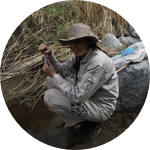About This Project
Spiders are abundant and very interesting invertebrates, but we lack much to know about their diversity and distribution, especially in North America where it is estimated that only 27% of arachnids have been studied and described. With this research, we seek to study the spiders of the genus Phidippus in North America, under a taxonomic, ecological, and evolutionary approach to evaluate its center of origin, geographic delimitation and divergence rates with parametric biogeography methods.
Ask the Scientists
Join The DiscussionWhat is the context of this research?
The spiders of the Salticidae family or also known as jumping spiders, are the family with the largest number of species, and the genus Phidippus has more than 60 species, and most of them are found in North America. These spiders are very charismatic due to their colors and size. This spiders have been studied in morphological and behavioral topics , and there is only one work on their phylogeny, but this was done based on their morphology. We know very well the biology and ecology of these spiders; however, we need to understand their evolutionary history, and for this, it is necessary to obtain dated phylogenies and combine parametric biogeography methods to estimate their center of origin, divergence rates, and phylogenetic diversity of the species in the North. America.
What is the significance of this project?
We know a lot about the ecology and biology of spiders; but, the patterns of distribution, evolution history, and diversification remain controversial. We need more work on comparative analysis of the evolution of spiders, using molecular phylogenies for a better understanding of the evolution of spiders.
The species of Phidippus are an ideal study model to explore this topics in North America, which will help us to learn more about the diversification patterns, evolutionary and historical-biogeographic processes that were the cause of their current distribution. In this sense, it is of great relevance this work, with it, we will have more detailed information about these amazing and charismatic spiders and about the geographic areas for these spiders.
What are the goals of the project?
We have two hypotheses; the first, species of the genus Phidippus are monophyletic, and their most recent common ancestor diverged after the Eocene in North America. The second is, Phidippus species diversified gradually since the Miocene.
To test our hypotheses, we first have to obtain a dated phylogeny; this phylogeny will be obtained with ultraconserved elements; these are regions within the genome that are shared between evolutionarily distant taxa. Once we get the dated phylogeny, we will be able to know which was the center of origin of the genus Phidippus in North America, how and when was its diversification and radiation and what were its evolutionary and historical biogeographic processes that shaped its current distribution.
Budget
We will carry out the primary fieldwork in the state of Baja, California, in the different habitats where this genus of spiders can be found. We will also perform DNA extraction, and it will be sent to a specialized laboratory for sequencing.
This project has a budget for these fieldwork; however, there is still an important activity to be carried out for which there is no budget. This activity is the visit to entomological collections in search of spiders of the genus Phidippus to be able to carry out the DNA extraction of species in the United States since the work will be on North America and sequencing the DNA extraction.
It is planned to visit entomological collections in New York at the American museum of natural history and San Francisco at the California Academy of Science.
In addition to museums' visits, it is required to buy a macro lens to take pictures of the spiders; this is important because it is necessary to record live spiders.
Endorsed by
 Project Timeline
Project Timeline
This research is part of my Ph.D. studies, where expeditions will be made throughout México and parts of USA, and we also plan to participate in congress to present our findings, to visit museums for morphological revisions. All this has to be done in four years, which is what my Ph.D. program lasts for.
May 03, 2021
Project Launched
May 14, 2021
Spiders Expedition
Oct 18, 2021
Museum Visit
Dec 01, 2021
DNA Extraction
Jan 03, 2022
Morphological Analysis
Meet the Team
Affiliates
Affiliates
Luis Hernandez
I graduated from the Autonomous University of Baja California in 2016 with a BSc in Biology. Later, I started to study an MSc in ecosystem management in the same institution. I am currently studying a PhD in Centro de Investigación Científica y de Educación Superior de Ensenada.
My research topic focuses on the use of spiders as bioindicators, although I have also worked on issues of arachnid biodiversity and public health impact issues, especially in the area of science dissemination in the city where i was born, Ensenada, Baja California, Mexico.
Luz Abril
I graduated as an environmental scientist from the Universidad Nacional Autonoma de Mexico (UNAM). I am currently working towards my MSc at Centro de Investigación Científica y de Educación Superior de Ensenada (CICESE).
My line of work is currently focused on the genetic identification of Phidippus specimens found in Baja California, México.
Sara Ceccarelli
I am fascinated by all lifeforms, but have a soft spot for spiders, which is why they are my main model organisms for the research I carry out on evolution and biogeography, at CICESE in northwestern Mexico. I obtained my BSc in Zoology from the University of Reading, UK, and my PhD on ant-mimicking jumping spiders from James Cook Uni in Townsville, Australia. Currently, I am a researcher in charge of the terrestrial arthropod collection at CICESE's Conservation Biology Department.
Project Backers
- 10Backers
- 7%Funded
- $430Total Donations
- $43.00Average Donation


